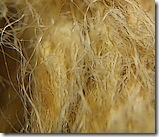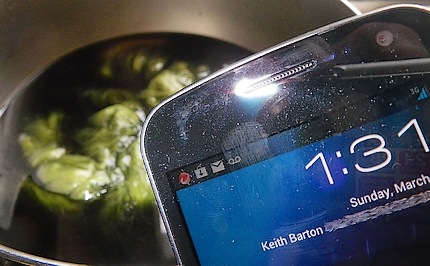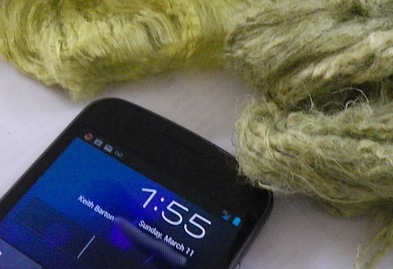 That last comment was innocent enough, but all the hellish labor, gnashing of teeth, and fits of cursing that go into a simple task like selecting final colors, are invisible to most .. as is the time spent sulking …
That last comment was innocent enough, but all the hellish labor, gnashing of teeth, and fits of cursing that go into a simple task like selecting final colors, are invisible to most .. as is the time spent sulking …
Dyeing is already a place most fear to tread, and the reality of choosing colors for dry flies is an agonizingly long effort.
So I’ll demonstrate my pain by asking, what color is that innocent little swatch featured above?
Dyeing materials for dry flies is not the rich and colorful business that is dyeing hackles for steelhead or big chunks of polar bear for streamers, rather colorations used for dry flies are typically pastel, a weak shade of color, not the lemon-yellow, orange-orange of your favorite breakfast cereal …
Instead you take an intentionally weak helping of color and dilute it so the colors are suitable for dry fly bodies; the pale olives, rusts, yellows, and grays, that make up your go-to colors.
“Weakening” is much worse to contemplate, given the many variables that affect bright colors, and how weak colors add more complexity given the many paths to dilution, including; additional water, pulling a material after a short immersion, or overwhelming a fixed amount of color with a large amount of materials.
… and while I continue to insist that dyeing fly tying materials is really quite easy, getting the same color a second time is &%#$@# impossible. Sure we write copious notes to record both keeper colors and clean misses, but when waxing lyrical – what exactly did you mean by “toothpaste green?”
Most colors of dye are mixtures of other colors, that when combined in a traditional bath, yield something similar to the label. A complex color like Olive, which contains yellow, green, and black, begs the question – which of the component colors dyes first?
If the black colors first, then yanking the material quickly yields a gray. If either the green (yellow+blue) dyes first – it’ll either be a dirty yellow, or a cold pale green – and if the yellow is first it’s liable to have a hint of either black or green, and will wind up a mustard.
Resolved to buy someone else’s efforts? So, have I …
 What’s complicating things is I’ve had my hard water softened compliments of Culligan, and the increased salt in the water has added a new wrinkle to old calculations.
What’s complicating things is I’ve had my hard water softened compliments of Culligan, and the increased salt in the water has added a new wrinkle to old calculations.
Even better is the announcement that well water is no longer fashionable in my town (read toxic) and how they’ll be pumping Sacramento River water in to mix with all the agricultural runoff. The resultant brew will have chemicals added, “to make it smell and taste better.”
Which means all my hard work will have to be redone in 2016, once construction is complete property values decline even more …
Until then, I continue to plunk perfectly good materials into an intentionally weak stew to come up with the twenty or thirty needed to make a good dry fly selection. Then I try to create them a second time the following week, after reading my careful worded notes …

This latest trial was for the Pale Morning Dun color (for the Hat Creek / Fall River drainage of California), and was a miss. The Pale Olive was the correct intensity but it needed a bit more yellow to match the version dyed last week.
Most vendor-created packaged dubbing change a couple shades with every run, they just run big batches that last a couple of seasons to make it less noticeable.
It’s easy enough to save the dull material at left, I’ll add it to a weak yellow bath for a minute or two and it’ll be nearly indistinguishable. It’s one of those hard lessons learned early, “ … that nothing can fix a dye job that’s too dark …”

Which is why after shipping out quite a few samples, I’ve gone silent over my latest brainchild.
Add in work-related travel, a winter that never came, and I’m behind on a great deal of efforts I was counting on completing during those dark, rainy, months between Christmas and Opening Day.
* The swatch above is Olive, yet the yellow component dyes first with only a hint of the black and green, yielding dirty Mustard. Care to try to get that a second time?

Color swatchs??? You’re SO Martha!
Just like paint. No two dye lots are he same no matter how hard you try.
Mark
What dye are you using? I’ve been using Pro Chemical and I’ve ran into maybe the same issue of the yellow portions of the dye taking much much longer to activate. Sometimes I risk overcooking the material just to get the shade to come our right.
I’ve also had a problem with the base of animal fur not taking the dye no matter how saturated I get the pelt. The dye hits the guard hairs first and soaks up all the dye before any gets to the underfur…
The best hands down, now that I know the effort put into it no other will suffice! Yeah I know, only a sample and I’m hooked now!
Rex,
In this case I’m using no heat to the liquid at all, I ran a series of tests using cold tap water, now I’m running the same series of dyes using hot water from the tap – no flame at all.
Yellow traditionally drops its colors first versus last, so I’d guess the amount of fixative was your issue, not bath temperature.
Keep in mind I don’t know whether the PH of your water is off due to locale (like mine is) which also can influence which color may drop.
Because I’m intentionally using too little dye (and fixative) to render a pastel color, the yellow in the Kiwi color needs more time to lay down on the mats.
With any dye you shouldn’t have to boil the mixture or risk destroying the material to get the label color, something else is at work.
Presoak your materials, and double up on your fixative (white vinegar [5% acetic] or try the Muriatic [hold your breath] which is a 10% sulfuric solution used to clean swimming pools).
In rare cases a material’s toughness can also resist coloration, like polar bear or jungle cock eyes.
WT – You’re a sick man to make me do this with my weekends.
Indeed I am a sick individual but Bruno says fishing is better on weekdays.
Keith, stay the course. Your sacrifice for the greater good will be rewarded (probably like all great artists, though, after you dead, the monetary reward accruing to someone else).
Like WT, having tasted the ambrosia I can no longer stomach an inferior concoction; for me it’s FREE RANGE OR NOTHING.
Keep changing your DNA by immersing yourself in those noxious dye baths so that I can tie pretty baubles.
Thanks! Good to know. I’ll go back and try some warm water immersions. I’m assuming I just let it soak for longer.